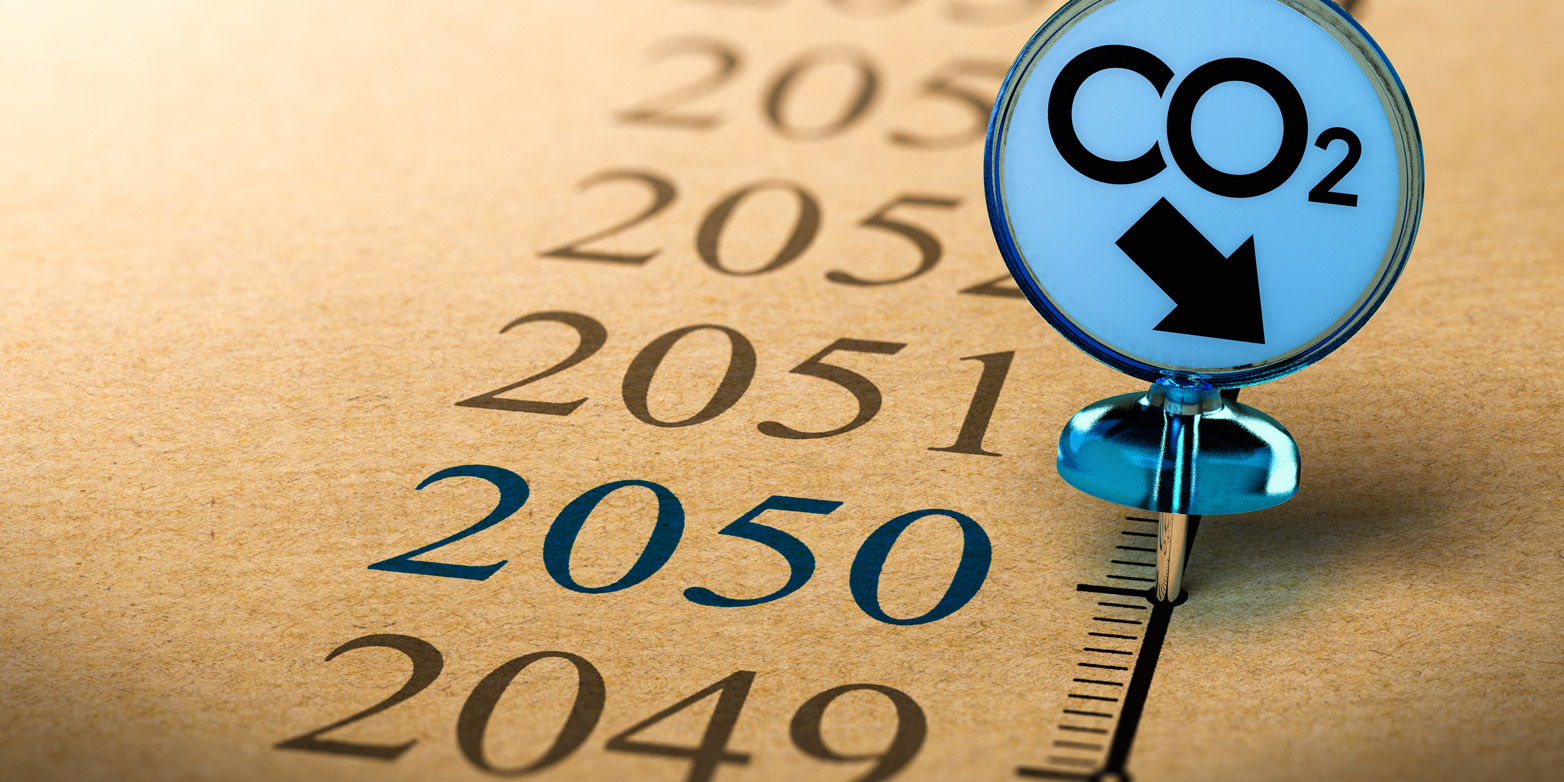Net zero needs a plan
It will take more than a long-term target for 2050 to achieve climate neutrality, says Reto Knutti. Policymakers must take a consistent approach towards net zero, and define a reduction path with specific measures and interim targets.

Following the defeat of the CO2 law in June, Swiss policymakers now face a considerable challenge. On the one hand, the interim target of a 50 percent reduction in greenhouse gases by 2030 must be maintained, with no current consensus on how this should be done. At the same time, the vote on the Glacier Initiative is approaching, which calls for the goal of “net zero 2050” to be written into the constitution. This would mean that as of 2050, Switzerland should not emit more greenhouse gases than natural and technical CO2 sinks can absorb.
The initiative has a good chance of passing – the canton of Bern accepted this target with a clear majority a few weeks ago, and the Federal Council has also included the net zero 2050 target in its direct counter-proposal to the Glacier Initiative. However, the unanimity is deceptive; parliament must clarify important points regarding content in its discussion of the counter-proposal in the coming weeks.

CO2 budget is the key
Firstly, it is not only the timing of net zero that is ultimately relevant for warming, but also our overall emissions. Every tonne of CO2 warms the planet, regardless of when and where it is emitted. This is why both the Glacier Initiative and the counter-proposal require at least a linear reduction pathway, as a central element in limiting overall emissions.
The decisive factor here would be to define a starting point for the linear reduction pathway, but this is currently not specified in either the Glacier Initiative or the counter-proposal. If there is only a date for net zero, then there is a risk of a policy based on waiting until 2040, only to realise that the accumulated emissions are too high and that a rapid reduction to zero is no longer possible.
The CO2 budget therefore indicates how much we can emit in total for a given temperature target. The “permissible” CO2 emissions are also dependent on the measures taken for other greenhouse gases, the probability of reaching the target and on what is seen as a fair contribution by Switzerland to the global effort. Even in the most optimistic case, assuming the same global emissions per capita for the future, the emissions envisaged in the Federal Council’s long-term climate strategy of January 2021 are about 40 percent above what would be necessary for 1.5°C.
If one argues on the basis of the principle of Common but Differentiated Responsibilities of the UN Framework Convention and includes past emissions and technical and financial possibilities, Switzerland would have to reduce its emissions even faster.
For example, if we continue at the current rate of reduction, we would be 2.5 times too high. So we are not on track. If emissions were to be halved by 2030 and then reduced linearly to net zero by 2050, total emissions would still be about 15 percent too high. In my view, this is the least that Switzerland should achieve and must be the basis for all proposals.
Ban on fossil fuels would lead the way
Secondly, the Glacier Initiative calls for fossil fuels to be phased out, but the counterproposal aims only to “reduce” their use as far as “economically viable”. Although economically viable is not the same as profitable, the wording nevertheless provides too much scope for rejection of the switch as too expensive.
The counterproposal also wants to see exceptions for emergency services and national defence. These exceptions are unnecessary, as CO2-neutral synthetic fuels already exist and there is time to build up the necessary production capacities by 2050. The admixture quotas for kerosene discussed by Switzerland and the EU create such incentives. A long-announced ban is also a strong incentive to develop other solutions and provides planning security.
Our children will suffer from our failures
Thirdly, there remains the question of who will pay, and which incentives will be effective. According to the German Environment Agency, each tonne of CO2 causes globally aggregated climate damage of about CHF 200 over time. The latest calculations are significantly higher.1
In addition, every tonne that places an excessive burden on the CO2 budget for a given temperature limit must be removed from the air again at some point (net negative emissions). These prices should drop from about CHF 600 today to CHF 200 for the next generation, but even then, we are costing them hundreds of francs per tonne. Currently, there is an incentive tax of about CHF 100 per tonne on fossil fuels in general, but not on power fuels or kerosene.
In short, we are paying only a fraction of the effective costs of fossil energy and leaving the bill to be paid by the younger generations. A model with an advance disposal fee, similar to the one that exists today on a small scale for electronic devices, would accelerate CO2 avoidance, promote other options and make it easier for our children to clean up.2 Investment programmes and limits are needed where price controls are not acceptable or insufficient due to a lack of other means.3
Price of negative emissions
Fourthly, key questions about negative emissions remain unanswered: how much greenhouse gas will be impossible or extremely difficult to avoid in the future? What potential do natural sinks and technical processes have to remove CO2 from the atmosphere? What are the costs? How should non-permanent sinks, such as forests and soil, be approached? And do negative emissions always have to be domestic, even when, as in Switzerland, suitable geological repositories are limited and sequestration is expensive?
Much is still unclear, but we need to develop and scale these technologies today if we want to use them effectively tomorrow. Similar to photovoltaics, it will take one to two decades for processes to be affordable and widely available. We must start now.
Risky political poker game
There’s a lot at stake: a pure net-zero target in the constitution would require further steps at the legislative level for implementation, which would be similarly controversial to the CO2 law. When the Glacier Initiative and its counterproposal are put before the people, there is also a risk of a double “no” vote, which would be fatal for Switzerland and its reputation.
“The most expensive approach is to do nothing.”Reto Knutti
The alternative, as now proposed by the National Council’s Environment Committee, is an indirect counter-proposal at the legislative level that could make the Glacier Initiative superfluous. It remains to be seen what will ultimately be accepted in parliament.
One thing is certain: with ratification of the Paris Agreement, Switzerland must make its contribution to a global net zero target. With its resources and excellent opportunities as an innovation location, it has a pioneering role to play. And it will pay off in the long run. The most expensive approach is to do nothing.
Despite all the uncertainties and sensitivities after the defeat of the CO2 law, the Federal Council and Parliament must focus on setting a consistent course for net zero in the proposals on the Glacier Initiative, and develop measures and interim targets in addition to the long-term target for 2050. Mitigation of greenhouse gas emissions can no longer be postponed.
A shorter version of this opinion piece was published on 10 October 2021 in external page NZZ am Sonntag.
References
1 Jarmo S Kikstra et al 2021. external page The social cost of carbon dioxide under climate-economy feedbacks and temperature variability. Environmental Research Letters 16 094037.
2 David A. Stainforth. external page ‘Polluter pays’ policy could speed up emission reductions and removal of atmospheric CO2. Nature 2021.
3 Article in the Zukunftsblog by Anthony Patt and Johann Lilliestam: An alternative to carbon taxes

Comments
No comments yet